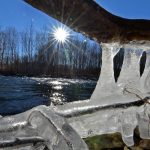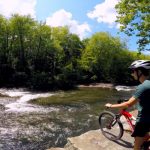BY JON O’CONNELL
A virtual kayak ride isn’t what it sounds like. It still requires getting wet.
The COVID-19 pandemic nixed the Lackawanna River Conservation Association’s popular Canoe-A-Thon, a race that summons hundreds of paddlers, along with its co-event RiverFest.
In the spirit of a Zoom-hosted happy hour, the association created the Lackawanna Challenge Virtual Kayak Run, which relies on the honor system for kayakers to track their time and river depth.
The challenge started at the end of May and continues until June 28. Kayakers can register and document their times through a link at www.lrca.org/events. Registration for the first run costs $25. Subsequent runs cost $10, and kayakers can improve their times if, for example, river depth improves and they want another shot.
Participants must be at least 12 years old. All will receive a T-shirt celebrating the Lackawanna River, which was voted Pennsylvania’s river of the year.
“It was a pretty good ride. The river’s really cleaned up since back in the ’70s. There’s very little garbage in it right now,” said Jeff Franchetti of Blakely.
He started kayaking on the Lackawanna River with his wife in 1980. He went out early for the Virtual Kayak Run.
Starting from the Parker Street Landing, he clocked his run at 58 minutes, a time he believed would be better if the water had been higher.
“The water was pretty low. We got stuck a couple times,” he said.
Depths between 2.6 feet and 3.2 feet, measured from the U.S. Geological Survey’s Archbald gauge, offer ideal kayaking conditions, according to Bernie McGurl, the association’s executive director.
“It’ll get you up and over most of the riffles with ease,” he said. “It doesn’t stay there very long without a heavy, sustained rain.”
About 4:30 p.m. on Sunday, the Archbald gauge read 2.4 feet. The river appeared devoid of kayakers willing to risk bottoming out.
“If we get a good heavy rain for six to 10 hours, then it’s going to be up for the better part of two or three days,” McGurl said.
Kayakers can take two routes, which both end at Sweeney’s Beach in Scranton.
The 3-mile Scranton Spring Challenge runs from Parker Street, where Franchetti started.
The 12-mile Archbald Whitewater Challenge for experienced kayakers starts at David Maslyar Park, along Laurel Street in Archbald.
Kayakers must record the river depth and discharge rate from the USGS gauges closest to their launch points, as well as their start, stop and lapse times.
“I don’t expect them to be able to click their stopwatch or their phone as soon as they hit the beach,” McGurl said, adding that he expects kayakers to be honest.
Times will be adjusted based on river depth.
Franchetti said typically he clocks 40 to 50 minutes to get from the Parker Street Landing to Sweeney’s Beach. For ShiverFest, the association’s cold-weather race, he clocked his fastest time, 30 minutes, because the river was high.
“It’s a good time,” he said, chuckling. “You get a little wet.”
Contact the writer: joconnell@timesshamrock.com; 570-348-9131



